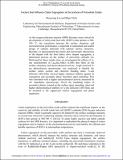Factors that Influence Cation Segregation at the Surfaces of Perovskite Oxides
Author(s)
Lee, Wonyoung; Yildiz, Bilge
DownloadYildiz_Factors that.pdf (375.2Kb)
PUBLISHER_POLICY
Publisher Policy
Article is made available in accordance with the publisher's policy and may be subject to US copyright law. Please refer to the publisher's site for terms of use.
Terms of use
Metadata
Show full item recordAbstract
As the oxygen reduction reaction (ORR) becomes more critical for development of solid oxide fuel cells (SOFCs) that operate at 500-700 °C, the correlation between the surface chemistry and electrochemical performance is important to understand and enable design of cathode materials with optimal surface chemistry. Recently we demonstrated that elastic and electrostatic interactions of the dopant with the host lattice drive dopant segregation, a detrimental process on the surface of perovskite cathodes [1]. Motivated by those results, here we investigated the effects of A-site stoichiometry in La0.8Sr0.2MnO3 (LSM) thin films on the surface chemistry and electrochemical activity. Angle-resolved X-ray photoelectron spectroscopy was employed to identify the surface cation content and chemical bonding states. A-site deficient LSM films showed higher chemical stability against Sr segregation and secondary phase formation upon annealing. This was correlated with a higher electrochemical activity measured by AC impedance spectroscopy. Given the insulating nature of secondary phases created on the surface upon annealing, observed higher electrochemical stability in A-site deficient LSM films can be ascribed to the suppressed surface segregation and phase separation.
Date issued
2013-10Department
Massachusetts Institute of Technology. Department of Nuclear Science and Engineering; Massachusetts Institute of Technology. Laboratory for Electrochemical InterfacesJournal
ECS Transactions
Publisher
Electrochemical Society
Citation
Lee, W., and B. Yildiz. “Factors That Influence Cation Segregation at the Surfaces of Perovskite Oxides.” ECS Transactions 57, no. 1 (October 6, 2013): 2115–2123. © 2013 Electrochemical Society.
Version: Final published version
ISSN
1938-6737
1938-5862